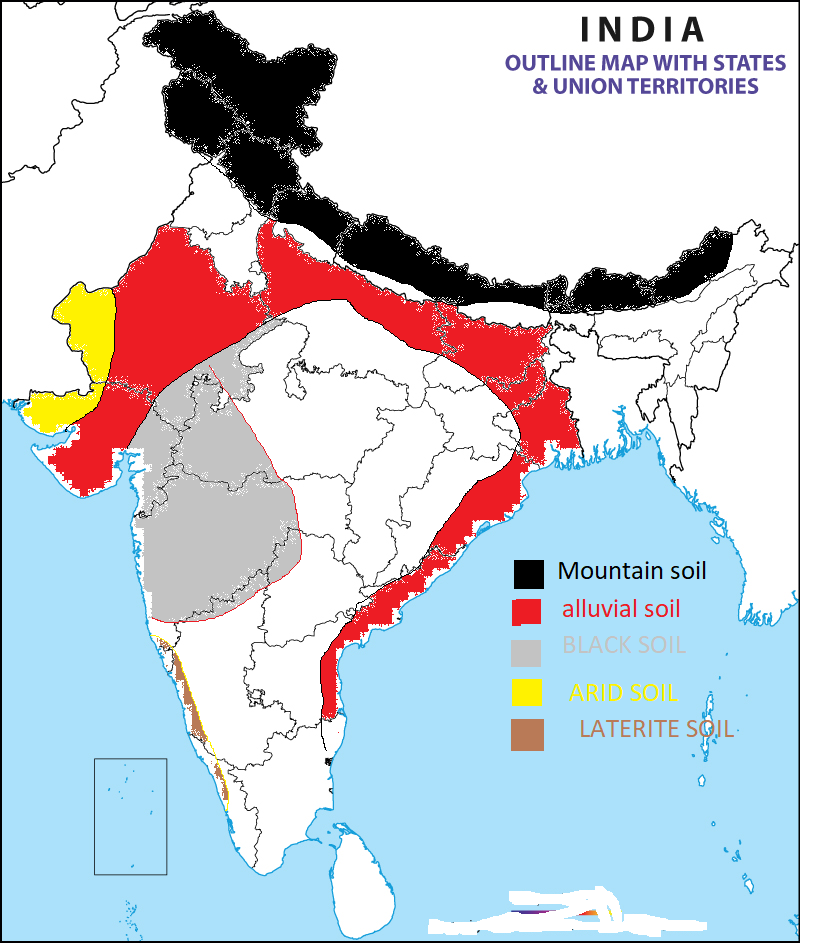
On the given outline map of India Mark and Label the following
1.Arid 2. Laterite soil 3. Mountain soil 4.alluvial soil 5. Balck soil
Answer
488.4k+ views
Hint: Soil is a material made out of five fixings — minerals, soil natural issue, living beings, gas, and water.
Complete answer: Map and it's description is given below :

1.Most Semi-arid soils are free-depleting yet get lacking precipitation to eliminate solvent salts. Such soils are artificially rich, although just moist enough for plant development for a brief timeframe every year.
2.Laterite is both a soil and a stone kind wealthy in iron and aluminum and is normally considered to have shaped in hot and wet tropical regions. Essentially all laterites are of corroded red tinge, in view of high iron oxide content.
3.The mountain soil is a profoundly filtered soil that is acidic in nature and is inadequately rich as well. It is found in Jammu and Kashmir, UP, West Bengal in Himalayas submontane tracks
4. Alluvial soils are inescapable in the northern fields and the stream valleys. Through a narrow corridor in Rajasthan, they stretch out into the fields of Gujarat.
5. Black soil covers the majority of the Deccan Plateau which incorporates portions of:
Maharashtra, Madhya Pradesh, Gujarat, Andhra Pradesh, and a few pieces of Tamil Nadu.
Note: Soil minerals structure the basis of soil. They are delivered from rocks through the cycles of weathering and erosion. Water, wind, temperature change, gravity, synthetic cooperation, living beings and pressing factor contrasts all assist break with bringing down parent material.
Complete answer: Map and it's description is given below :

1.Most Semi-arid soils are free-depleting yet get lacking precipitation to eliminate solvent salts. Such soils are artificially rich, although just moist enough for plant development for a brief timeframe every year.
2.Laterite is both a soil and a stone kind wealthy in iron and aluminum and is normally considered to have shaped in hot and wet tropical regions. Essentially all laterites are of corroded red tinge, in view of high iron oxide content.
3.The mountain soil is a profoundly filtered soil that is acidic in nature and is inadequately rich as well. It is found in Jammu and Kashmir, UP, West Bengal in Himalayas submontane tracks
4. Alluvial soils are inescapable in the northern fields and the stream valleys. Through a narrow corridor in Rajasthan, they stretch out into the fields of Gujarat.
5. Black soil covers the majority of the Deccan Plateau which incorporates portions of:
Maharashtra, Madhya Pradesh, Gujarat, Andhra Pradesh, and a few pieces of Tamil Nadu.
Note: Soil minerals structure the basis of soil. They are delivered from rocks through the cycles of weathering and erosion. Water, wind, temperature change, gravity, synthetic cooperation, living beings and pressing factor contrasts all assist break with bringing down parent material.
Recently Updated Pages
Master Class 11 Economics: Engaging Questions & Answers for Success

Master Class 11 Accountancy: Engaging Questions & Answers for Success

Master Class 11 English: Engaging Questions & Answers for Success

Master Class 11 Social Science: Engaging Questions & Answers for Success

Master Class 11 Biology: Engaging Questions & Answers for Success

Master Class 11 Physics: Engaging Questions & Answers for Success

Trending doubts
Difference Between Plant Cell and Animal Cell

Name 10 Living and Non living things class 9 biology CBSE

Fill the blanks with the suitable prepositions 1 The class 9 english CBSE

On an outline map of India show its neighbouring c class 9 social science CBSE

What is the Full Form of ISI and RAW

The highest mountain peak in India is A Kanchenjunga class 9 social science CBSE




